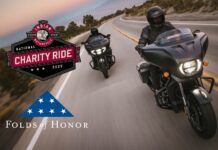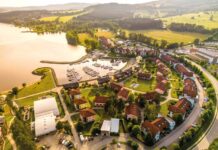MILWAUKEE, AUG. 29-SEPT. 1,–Former longtime Harley-Davidson executive Clyde Fessler is generally given credit for coming up with the idea of the Harley Owners Group. Several years ago, he told me that no one at Harley-Davidson envisioned what H.O.G. would become. “We thought we’d get about 25,000 people nationwide, sell a few patches, sell a few pins and have a good time.” Today’s H.O.G. has grown far beyond the wildest estimates. There are about one million members around the world. Additionally, there are about 680 chapters in the U.S. and, at last count, over 700 chapters in faraway places; countries where you might not expect to hear the rumble of a Harley—100 countries in all. The numbers stagger the imagination. What hath Clyde wrought?

Every organization that observes its 30th anniversary has an old and a new; a past and a present. There are first-timers and old-timers, veterans and rookies and a whole lot of folks in between. This was on display with H.O.G.’s 30th birthday, celebrated and commemorated in Milwaukee this year in conjunction with Harley-Davidson’s 110th anniversary. Willie G. and Nancy Davidson were there, with their, respectively, #1 and #2 membership cards dating from 1983. And the Summerfest Grounds was flooded with the vintage and the youthful, including a substantial number of rallygoers from foreign lands.
In the beginning was the rally, which became H.O.G.’s stock in trade. H.O.G. was formed in 1983, and its first event was a three-day Magic Mountain Tour, as 250 members took a ride around Greeley, Breckenridge and Colorado Springs. H.O.G.’s first two national rallies were held in Reno, Nevada, and Nashville, Tennessee, in 1984. The following year’s rally was at Branson, Missouri, and in 1986 Pigeon Forge, Tennessee, hosted the event.

In 1986, H.O.G. expanded their rally quotient with three regional rallies to go along with the national rally at Pigeon Forge. Regional rallies were held in Nashville, Michigan; Breckenridge, Colorado; and San Juan Capistrano, California. Regional and national rallies dominated National H.O.G.’s event calendar for many years. The calendar was supplemented by “pin stops” and receptions at race tracks, Harley-Davidson dealerships and major motorcycle rallies such as Aspencade in Colorado, Americade in New York, Sturgis in South Dakota, and Daytona in Florida.
The advantage of regional rallies was evident. Members from adjacent states traveled shorter distances, but were still able to breathe the H.O.G. experience. Moreover, the regional rallies decreased attendance at the national rallies. This was important because as attendance expanded at national rallies, it became increasingly difficult to find rural venues large enough to host the event. Large-capacity motel blocks are concentrated in urban areas, which are less than ideal sites for motorcycle rallies. Initially, most of the rally attendees could fit in one large hotel. But H.O.G. quickly outgrew its own expectations. At a national rally in Lancaster, Pennsylvania, for example, over 10,000 people waltzed into Amish country and H.O.G. members were spread all over the countryside, dodging horse-and-buggy traffic.

Rallies gave members a sense of national unity. Chapter members from various states mingled with others and friendships developed. Officers from struggling H.O.G. chapters compared their efforts with lessons from more successful chapters. National H.O.G. soon offered chapter training for officers who were at the rallies, and these study sessions became the forerunner of more intensive Primary Officer Training (later, H.O.G. Officer Training) instruction.

The rally mania was insatiable. H.O.G. members wanted more, and the concept of state rallies was born. State H.O.G. rallies formed another link in H.O.G.’s commitment to maintain contact with its members. New York and Indiana inaugurated the state rallies in 1988, and every state in the union followed, some within a year, others shortly after that. State rallies diffused attendance from national rallies even more, but it concentrated organizing efforts on one or two local host chapters. In time, state rally committees were formed and trained by H.O.G., which helped alleviate the yearlong load of organizing a rally and spread the responsibility to many hands. As state rallies became more popular, regional rallies disappeared.
State rallies moved around the state, from one locale to another. Some rallies were urban, some were rural, but most were somewhere in between. Some needed a phalanx of motels, some filled resort complexes and others clustered near camping grounds and a few Motel 6s. The mix of rally sites enabled H.O.G. members to enjoy all the attractions of their own state. Neighboring states drew H.O.G. members from bordering states, providing a cosmopolitan mix. Essentially, H.O.G. was taking people to places they didn’t know had places. Smaller states, without the resources to organize their own rally, merged with adjoining states to combine resources.
As times changed, H.O.G. abandoned stationary rallies in favor of riding rallies, patterned after the Gypsy Tour concept developed by the AMA years earlier. Examples of successful riding rallies included an end-to-end tour of Route 66, starting from Grant Park in Chicago, Illinois, and ending on the beaches of Santa Monica, California. Another tour was the Lewis and Clark Ride, which covered territory from St. Louis, Missouri, to the coast of Oregon. H.O.G. also featured Posse Rides, where the riding was fast and furious, sometimes from coast to coast, leaving nothing but dust and the weak in its trail. There have been riding rallies around the Great Lakes, up and down the Mississippi and along roads and highways all over the United States.
The most successful rallies, as far as sheer numbers are concerned, have been the anniversary rallies. Organized at five-year intervals, riders congregated in Milwaukee to celebrate, starting with the 85th anniversary of Harley-Davidson in 1988, where attendance was sparse by comparison with later rallies—only 60,000 attendees. This year, as Harley-Davidson observed its 110th anniversary and H.O.G. its 30th, hotels were booked well over a year in advance.
In 1985, H.O.G. chapters were organized at sponsoring dealers. Steve Piehl, the first director of H.O.G., stated recently in an interview that when H.O.G. was organized in 1983, “we never had a thought that there would be H.O.G. chapters at every Harley dealer in the world. We never even dreamed of H.O.G. chapters. Chapters came about a year later as a result of our members asking for a structure that helped them get even more engaged with H.O.G.”
In recent years, H.O.G. chapters in the U.S. have become more self-sufficient, withdrawing from Milwaukee’s hand-holding. There is still the annual officer training, as well as for state rally chairpersons, but some regional managers have been incorporated into Harley’s marketing department, assisting dealer events and other functions. The growth of H.O.G. has been overseas, in foreign countries, where progress has been phenomenal.
Overseas H.O.G. activity commenced in the late 1980s, but there have been Harley events in Europe for generations. As far back as 1964, there was a Harley Jamboree sponsored by the Brussels Harley-Davidson Riders Club Tremeloo in Flemish Brabant. Only a few years after H.O.G. was established in the U.S., European Harley riders caught the spark. In 1989, Europe’s first H.O.G. chapter, Rolling Hills H.O.G., was formed in England. The first European H.O.G. Rally was held in 1991, in Cheltenham, England, with 3,500 attendees. The second European H.O.G. Rally was held the next year in Colmar, France. From then, H.O.G. mushroomed into a large and sprawling event team. H.O.G. set up an international headquarters in Moerfelden, Germany, in 1995. Since then, Europe has staged H.O.G. rallies annually in exotic locations such as St-Tropez, Rome, Barcelona, Killarney, and in most European capitals. In 2014, there will be a Pan-European Posse Ride, the fourth, from Berlin to Valencia, passing through Switzerland and France. Over 100 members will enjoy 16 days of touring.

It was not only Europe that caught the H.O.G. fever. The first Japanese H.O.G. Rally bloomed in 1996. That same year, a H.O.G. chapter was established in Lebanon. In 2000, Brazil was the site of the first South American Regional H.O.G. Rally. In 2009, the “1st Mainland China Rally” originated; there have been four subsequent China rallies. H.O.G. has spread to the Middle East, to South Africa, to a military base in Sicily, to Australia, New Zealand and most of the Far East. There is a H.O.G. magazine, in several languages, that has published four issues. Its best is yet to come.

What is H.O.G. to be in the future? H.O.G. is breathtakingly varied; impossible to grasp easily. It has so many facets—national and international—that one is stunned at its picturesque complexity. Undoubtedly, the digital age will tweak the familiar H.O.G., adding new dimensions to a successful enterprise. For example, the U.S. H.O.G. magazine, which replaced H.O.G. Tales and The Enthusiast, now offers members a digital version for iPad and other electronic devices. This is only the beginning.
Yet, reduced to the basics, H.O.G. is easy to understand. Its mantra, “Ride and Have Fun,” is maddeningly simplistic, but translates colorfully into many languages—”Ride et amusez-vous,” “Paseo y divertirse,” “Reiten und Spaß haben,” “Komfort jazdy i zabawy,” and “Viaggiare e divertirsi.” Nigel Villiers, director of H.O.G. and Customer Experience International, said it best. “Sharing experiences or road stories over chicken’s feet in Beijing, a ‘barbie’ in Australia, or a longhorn steak in Texas is what makes it all worthwhile to me.” Or, as Mae West once said, “Too much of a good thing is wonderful.”
The chronicle of H.O.G. is one of accommodation and innovation. It’s safe to say that no other organization has comprised such an exacting following. The best ideas in H.O.G.’s history have reflected the passion of its members; the pressure to get better, to do better, to be better has always been upward. It’s also true that no other motorcycling organization in history has successfully answered the demands of its members for so long a period. H.O.G. has responded with local chapters for those who enjoy the provincial scene, and with rallies—state, regional, national, and international—for those who follow the sun and believe that life begins on the off-ramp. The next passage is dawning. Now.



















I am trying to change my address to Germany. Have been unable to contact the main office of Harley Owners Group – Germany. Please contact me.